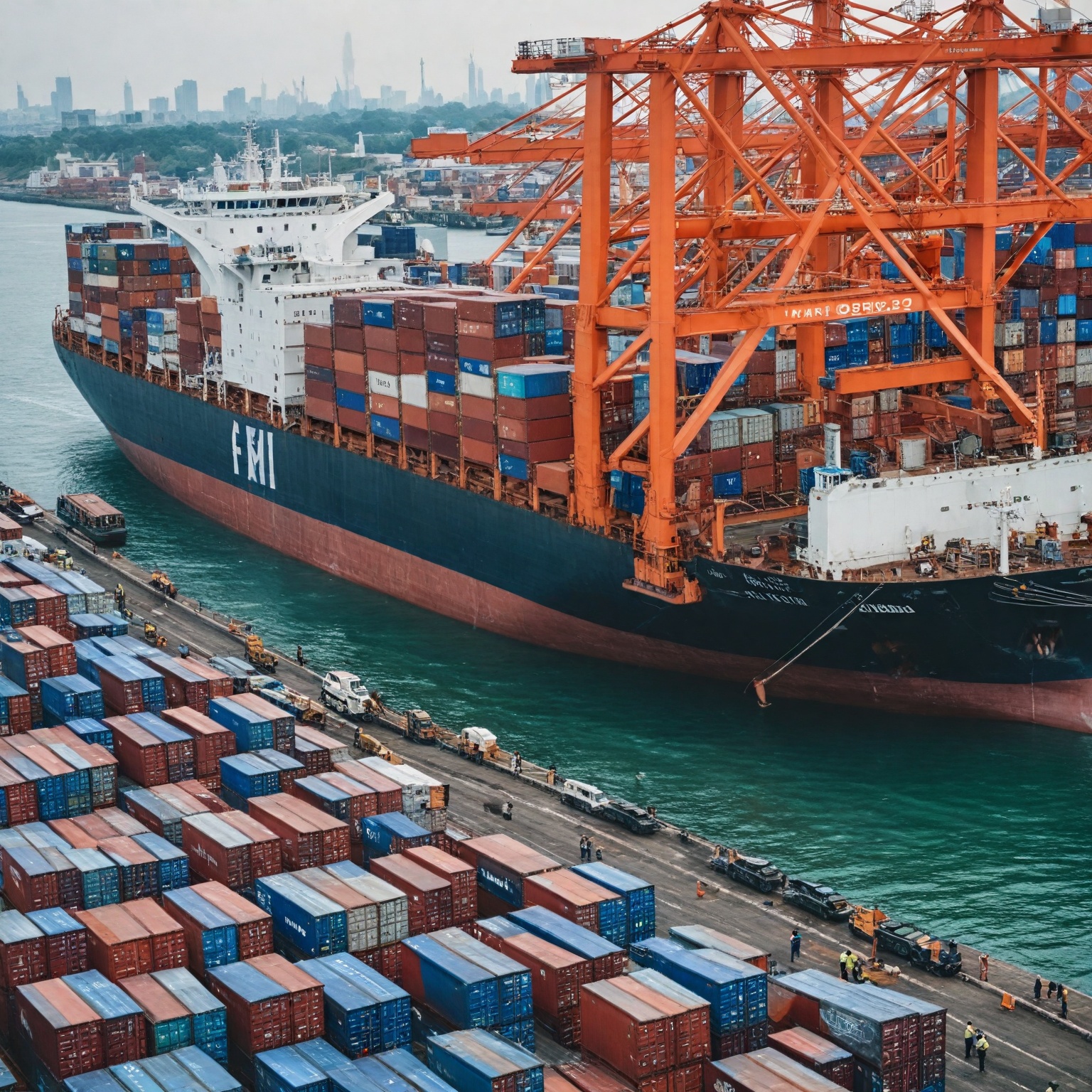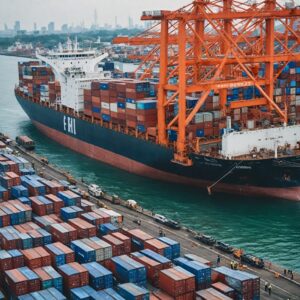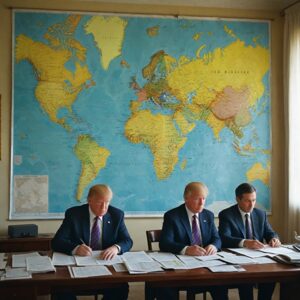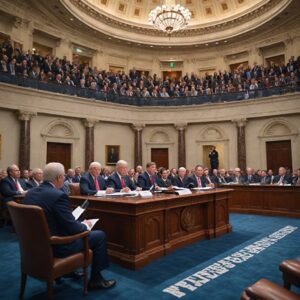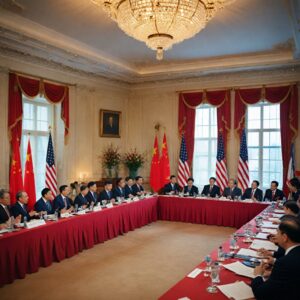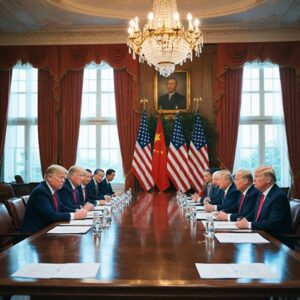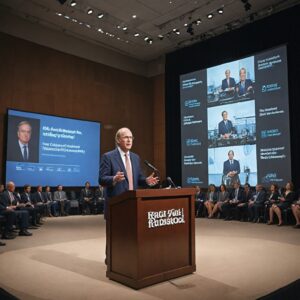Summary
The trade relationship between India and the United States, a key component of their broader strategic partnership, has encountered significant challenges due to recent tariff disputes. While bilateral ties have strengthened over the past decades, especially in economic and defense cooperation, tensions escalated when the U.S. imposed a blanket 25% tariff on Indian goods effective August 2025, dramatically increasing duties on critical Indian exports such as pharmaceuticals, electronics, textiles, and engineering products. This move marked a sharp departure from previous tariff levels and intensified uncertainty in one of the world’s most important trading relationships.
The imposition of higher U.S. tariffs has disrupted established trade flows, placing substantial pressure on Indian exporters who rely heavily on the American market—whose share of India’s exports grew from 15.6% to 18.3% in recent years. Key sectors including automobile components, gems and jewelry, agriculture, and textiles have faced heightened costs and competitive disadvantages. Although some segments, like pharmaceuticals, remain exempt, the overall tariff escalation threatens export-driven growth and has prompted warnings from Indian industry bodies such as the Chamber of Trade and Industry (CTI), which advocates for urgent government action and market diversification.
In response, India is actively pursuing a two-pronged strategy: continuing negotiations with the United States to seek tariff relief and simultaneously expanding export markets beyond traditional Western partners. Efforts to diversify include targeting emerging regions in Latin America, Africa, and Southeast Asia, where demand is rising and geopolitical tensions are comparatively lower. Additionally, India is leveraging supply chain realignment strategies such as on-shoring, near-shoring, and friend-shoring to reduce vulnerability to trade disruptions, reflecting a broader global trend of adapting to a more volatile international trade environment.
The ongoing tariff dispute highlights the complex interplay of protectionist policies, geopolitical considerations, and economic diplomacy shaping India-U.S. relations. While recent diplomatic efforts, including the resolution of several WTO disputes, demonstrate a shared interest in maintaining constructive engagement, the conflict underscores the urgency for India to bolster export resilience through diversification and innovation. The trajectory of this dispute and its resolution will significantly influence not only bilateral trade but also the broader patterns of global commerce in an era marked by shifting alliances and economic nationalism.
Background
The trade relationship between India and the United States has experienced significant fluctuations over the years, influenced by both geopolitical factors and evolving economic policies. Since India’s independence, bilateral ties have endured periods of distrust, particularly during the Cold War era and over India’s nuclear program. However, relations have warmed considerably in recent years, marked by increased cooperation on various strategic and economic fronts.
In the realm of trade, tariffs have been a central point of contention. India’s average tariff rate has declined from over 20% in 2000 to below 10% as of 2023, reflecting efforts to liberalize its trade regime. Conversely, U.S. tariffs on Indian goods, which peaked at 3.9% in 2001, had decreased to around 2.6% by 2023. Despite these reductions, tensions escalated when the United States imposed a reciprocal tariff of 27% on Indian goods, and later, a blanket 25% tariff effective August 7, 2025. This latter measure notably excluded product-level exemptions, impacting critical sectors such as pharmaceuticals and electronics, and positioning India among the most heavily tariffed nations under the new U.S. regime.
These tariff disputes have been a source of significant uncertainty in global trade, with concerns voiced by international figures such as WTO Director-General Ngozi Okonjo-Iweala about the negative consequences for global growth, especially for vulnerable economies. Despite recent progress, including the dropping of seven longstanding World Trade Organization (WTO) disputes between the two countries during state visits in 2023, tariff-related challenges remain a critical issue.
Within India, the Confederation of Tanzania Industries (CTI) and the Chamber of Trade and Industry have expressed strong reservations regarding the U.S. tariff increases. The CTI, representing local industry interests, actively lobbies for policy reforms and participates in trade forums to advocate for Indian manufacturers. Similarly, the Chamber of Trade and Industry has warned that the additional 25% U.S. tariff, which escalates total duties to 50% on Indian goods, could severely disrupt export-driven businesses, particularly in engineering, gems, textiles, and pharmaceuticals sectors. The Chamber’s leadership has urged the Indian government to consider retaliatory tariffs on U.S. imports and to take immediate strategic action to mitigate the adverse effects on Indian exporters.
Given the growing importance of the U.S. as a trading partner—whose share in India’s exports rose from 15.6% to 18.3%—these tariff disputes pose risks not only to specific industries but also to the broader stability and diversification of India’s export markets. Efforts are underway to negotiate a Bilateral Trade Agreement that could reduce tariffs on U.S. imports valued at $23 billion and enhance market opportunities for both sides, yet the current tariff environment underscores the urgency for India to diversify its trade partnerships, including expanding into the European Union and ASEAN markets.
Impact of the Tariff Disagreement
The tariff disagreement between India and the United States has introduced significant shifts in bilateral trade relations, affecting various sectors of the Indian economy. The United States’ imposition of a 25–26 percent tariff on Indian imports, aimed at addressing trade imbalances, has created both challenges and opportunities for Indian exporters.
Several key industries in India that depend heavily on exports to the U.S.—including electronics, textiles, agriculture, seafood, dairy, wine, diamonds, chemicals, and automobile components—face notable disruptions due to the increased tariffs. For instance, the automobile sector, which had the U.S. as its largest export market accounting for 27 percent of a US$21 billion export value in FY 2023-25, is expected to come under substantial pressure with the introduction of a 25 percent tariff effective April 5, 2025. Similarly, the gem and jewellery sector, with the U.S. as its single largest market representing nearly 30 percent of its global trade worth over $10 billion, is deeply concerned about the impact of tariff changes and any potential modifications to duty-free arrangements for cut and polished diamonds.
Despite these challenges, some sectors exhibit resilience. Pharmaceuticals, which constitute 10 percent of U.S. exports from India, remain exempt from the tariffs, and textiles, representing 12 percent, may even benefit as higher tariffs on competitors create relative advantages. Additionally, engineering goods and gems, though facing difficulties, maintain diversified markets beyond the U.S., potentially cushioning the impact.
The tariff escalation coincides with broader global trade realignments. India has emerged as a significant beneficiary of post-pandemic supply chain diversification and the fallout of US-China trade tensions. U.S. businesses seeking alternatives to China have increasingly favored India for its competitive labor market, growing manufacturing capabilities, and large domestic consumer base, positioning the country to potentially gain from the relative competitiveness of its exports amid new U.S. tariffs on China. However, the uncertainty surrounding the final trade deal and the possibility of tariffs settling in the 15–20 percent range remains a concern, prompting expectations of monetary policy easing by India’s central bank to sustain growth.
In response to tariff pressures, Indian exporters are adopting diversification strategies, including exploring new markets, broadening product portfolios, and considering on-shoring, near-shoring, and friend-shoring approaches. These measures aim to mitigate risks associated with the ‘new normal’ of global trade, characterized by volatility due to conflicts, uncertain tariffs, and export restrictions. The micro, small, and medium enterprises (MSME) sector, which saw its export contribution decline from 49.8 percent in 2019-20 to 45 percent in 2021-22, faces particular challenges related to market information, unfamiliar foreign operations, and access to distribution channels, underscoring the need for enhanced support amid changing trade dynamics.
Indian Government and Diplomatic Responses
The Indian government has actively engaged in diplomatic efforts to manage and resolve the ongoing tariff disagreements with the United States. Following years of fluctuating relations marked by Cold War–era distrust and nuclear program tensions, India has sought to strengthen its strategic and commercial ties with the U.S., viewing it as a crucial global partner. This has included participating in high-level dialogues such as the United States-India Trade Policy Forum, where both sides have committed to deepening and diversifying their bilateral trade relationship.
In response to tariff disputes, India has demonstrated a dual approach of negotiation and market diversification. While talks with the U.S. continue—sometimes marked by cautious optimism—India is simultaneously advancing trade agreements with other regions, including the European Union and the Maldives. This strategy not only lessens India’s dependence on any single partner but also provides leverage in trade negotiations, allowing it to mitigate the impact of potential U.S. tariff measures by accelerating deals elsewhere.
Diplomatically, India has participated in multilateral efforts to de-escalate tensions and resolve trade disputes, including the termination of six World Trade Organization (WTO) disputes involving both India and the United States. These actions underscore India’s commitment to maintaining a rules-based international trade order and reducing trade friction with the U.S.. The Indian government continues to emphasize collaboration and constructive engagement to foster mutual economic growth and global stability amid the ongoing tariff challenges.
CTI’s Role and Recommendations
The Chamber of Trade and Industry (CTI) has played a pivotal role in addressing the challenges arising from the recent escalation of tariffs between India and the United States. Following the US decision to impose an additional 25% tariff on Indian goods—raising the total duty to 50%—CTI expressed strong concerns over the adverse impact on India’s export-oriented sectors, including engineering, gems, textiles, and pharmaceuticals. Through its advocacy and policy engagement, CTI aims to represent the interests of domestic industries, highlighting the risks posed by such protectionist measures to Indian businesses.
Beyond advocacy, CTI underscores the importance of strategic responses to the evolving global trade environment marked by uncertain tariffs and trade restrictions. It recommends that Indian exporters diversify their market focus away from traditionally Western-centric trade partners, particularly the US, towards emerging markets in Latin America, Africa, and parts of Southeast Asia, where demand is growing and geopolitical tensions are comparatively lower. This approach aligns with broader global trends advocating for regional diversification, on-shoring, near-shoring, and friend-shoring to build resilience against trade shocks.
Additionally, CTI promotes the use of robust auditing tools such as customer type indicator (CTI) codes to enhance transparency and traceability in trade transactions, ensuring priority and compliance are maintained throughout order flows. By leveraging such mechanisms alongside policy recommendations, CTI aims to support Indian industries in navigating the complexities of international trade while advocating for legislative reforms that bolster industrial competitiveness.
Market Diversification Strategies
Amid rising trade tensions and the imposition of additional tariffs by the United States on Indian exports, market diversification has become a critical strategy for Indian exporters seeking to mitigate risks and sustain growth. The need to move beyond traditional Western markets, particularly the US, is underscored by shifts in global trade dynamics and geopolitical challenges that have made reliance on a single market increasingly precarious.
Indian policymakers and industry leaders emphasize exploring and expanding into emerging markets such as Latin America, Africa, the Middle East, and parts of Southeast Asia. These regions offer growing demand with comparatively lower geopolitical friction, making them attractive alternatives to US and European markets, which are becoming more protectionist and complex to navigate. Diversification strategies include broadening the export basket beyond conventional sectors, introducing new products, and tapping into less saturated consumer bases.
Furthermore, there is a parallel effort to restructure export supply chains through mechanisms like on-shoring, near-shoring, and friend-shoring, aimed at reducing dependency on vulnerable trade routes and politically sensitive origins. The Indian government has also supported sectoral upgrades to enhance competitiveness, such as recommending shifts from cotton-based textiles to man-made fibers and implementing technology upgradation schemes to improve efficiency and product quality.
Specific sectors face distinct challenges and opportunities in this diversification drive. For instance, electronics and solar contract manufacturers confront severe pricing pressures, while textiles and apparel might benefit from higher US tariffs on Chinese competitors, potentially increasing India’s market share in certain low-cost categories. At the same time, industries like pharmaceuticals are somewhat insulated due to tariff exemptions, allowing them to maintain steady export growth despite broader trade disruptions.
Companies like Eastman exemplify successful diversification by building strong distribution networks across Africa, Latin America, and the Middle East, leveraging India’s skilled workforce and favorable manufacturing policies to maintain resilience amid global tariff shocks. Nonetheless, exporters face margin compression as tariffs increase costs for end consumers, which can lead to price reductions and thinner profitability.
Challenges and Opportunities in Market Diversification
Asia’s growing internal demand, particularly within ASEAN, India, and the Middle East, has shifted the global trade landscape, compelling companies to realign their innovation and go-to-market strategies away from a Western-centric focus. For Indian exporters, this trend is both a challenge and an opportunity as they seek to diversify markets in response to increased tariffs and trade barriers imposed by the United States and the European Union. These barriers, including mechanisms such as the EU’s Carbon Border Adjustment Mechanism (CBAM), have added import duties on key Indian exports like fertilizer, aluminum, and cement, disproportionately impacting smaller manufacturers in the MSME sector who may lack the financial capacity to adapt swiftly.
In light of these obstacles, India is actively exploring new export destinations beyond traditional Western markets. Regions such as Latin America, Central America, the Middle East, and Africa are emerging as competitive yet promising markets where demand is growing and geopolitical tensions are comparatively manageable. However, increased competition in these regions is expected to intensify price pressures and compress profit margins, potentially limiting the availability of capital for reinvestment in innovation and capacity expansion.
Countries across Asia are also adopting broader strategies to cope with global trade disruptions, including diversification of source countries and markets, as well as efforts in on-shoring, near-shoring, and friend-shoring to mitigate risks associated with origin-based tariffs and supply chain uncertainties. For Indian exporters, navigating these complexities requires balancing the pursuit of new market opportunities with overcoming tariff and non-tariff barriers, while also addressing challenges related to export controls and bilateral trade negotiations, particularly with the United States.
Ultimately, while the evolving trade environment poses significant challenges, it also offers a pivotal moment for Indian and Asian enterprises to redefine their global engagement by focusing on non-aligned markets and leveraging internal regional demand, thereby reducing dependence on Western markets and enhancing resilience amid geopolitical shifts.
Case Studies
Several significant developments illustrate the evolving dynamics of India-US trade relations amid the ongoing tariff disagreements, highlighting both challenges and opportunities for diversification.
One notable example is the June 2023 agreement between General Electric and Hindustan Aeronautics Limited to co-produce the F-414 engine for India’s indigenous Tejas light fighter aircraft. This deal represents a strategic collaboration in defense manufacturing, reflecting deeper industrial ties beyond traditional trade sectors.
In response to the United States’ imposition of a 26 percent tariff on Indian imports, key Indian export sectors such as electronics, textiles, and agriculture have faced considerable pressure. The tariff aims to address trade imbalances but has compelled Indian exporters to quickly adapt their cost structures, optimize logistics, and enhance brand positioning to remain competitive in the US market. At the same time, Indian exporters are actively exploring new global markets as part of a diversification strategy, focusing on regions like the Middle East, Africa, and Latin America where Indian products—particularly in renewable energy and power solutions—are gaining momentum.
This pivot towards new markets is further underscored by India’s efforts to reduce dependence on the US by broadening its export destinations. Despite the challenges, maintaining US market access remains a priority, requiring Indian businesses to balance adaptation and expansion strategies carefully.
On the US side, recent tariff adjustments aim to restore and expand market opportunities for American agricultural producers and manufacturers while preserving the integrity of existing Section 232 measures. These developments coincided with Prime Minister Narendra Modi’s official state visit to the United States, which reinforced the importance of the bilateral relationship and cooperation on shared priorities across economic and strategic domains.
Together, these case studies highlight the complex interplay of trade policy, industrial collaboration
Future Outlook
The escalating tariff dispute between India and the United States has created significant uncertainty for Indian exporters, particularly in key sectors such as engineering, textiles, pharmaceuticals, and marine products. With the U.S. imposing an additional 25% tariff on Indian goods—bringing the total duty to 50%—exporters face substantial challenges that may disrupt established trade flows and supply chains. This development necessitates a strategic response to mitigate adverse impacts and capitalize on emerging opportunities.
In light of these challenges, the Chamber of Trade and Industry (CTI) has advocated for a diversification of India’s export markets beyond the traditional Western-centric focus. This approach aims to reduce overreliance on the U.S. market, which is becoming increasingly protectionist, and instead target regions with growing demand and more manageable geopolitical risks, such as Latin America, Africa, and Southeast Asia. Such diversification aligns with broader global trade trends, where countries are adapting to a “new normal” characterized by supply chain vulnerabilities, trade conflicts, and shifting tariff regimes.
Furthermore, diversification efforts could also leverage the ongoing co-production initiatives within India’s defense sector, such as the General Electric and Hindustan Aeronautics Limited partnership on the F-414 engine for the “Tejas” fighter. These collaborations symbolize the potential for deepening domestic capabilities and expanding exports in high-technology areas, which may be less sensitive to tariff fluctuations.
Ultimately, India’s export resilience will depend on its ability to navigate complex international trade dynamics by fostering new trade partnerships, enhancing competitiveness across sectors, and implementing adaptive policy measures. The period leading up to the mid-August deadline for a long-term trade deal with the U.S. remains critical, but longer-term strategies emphasizing market diversification and supply chain realignment will be essential for sustainable growth amid evolving global trade tensions.

